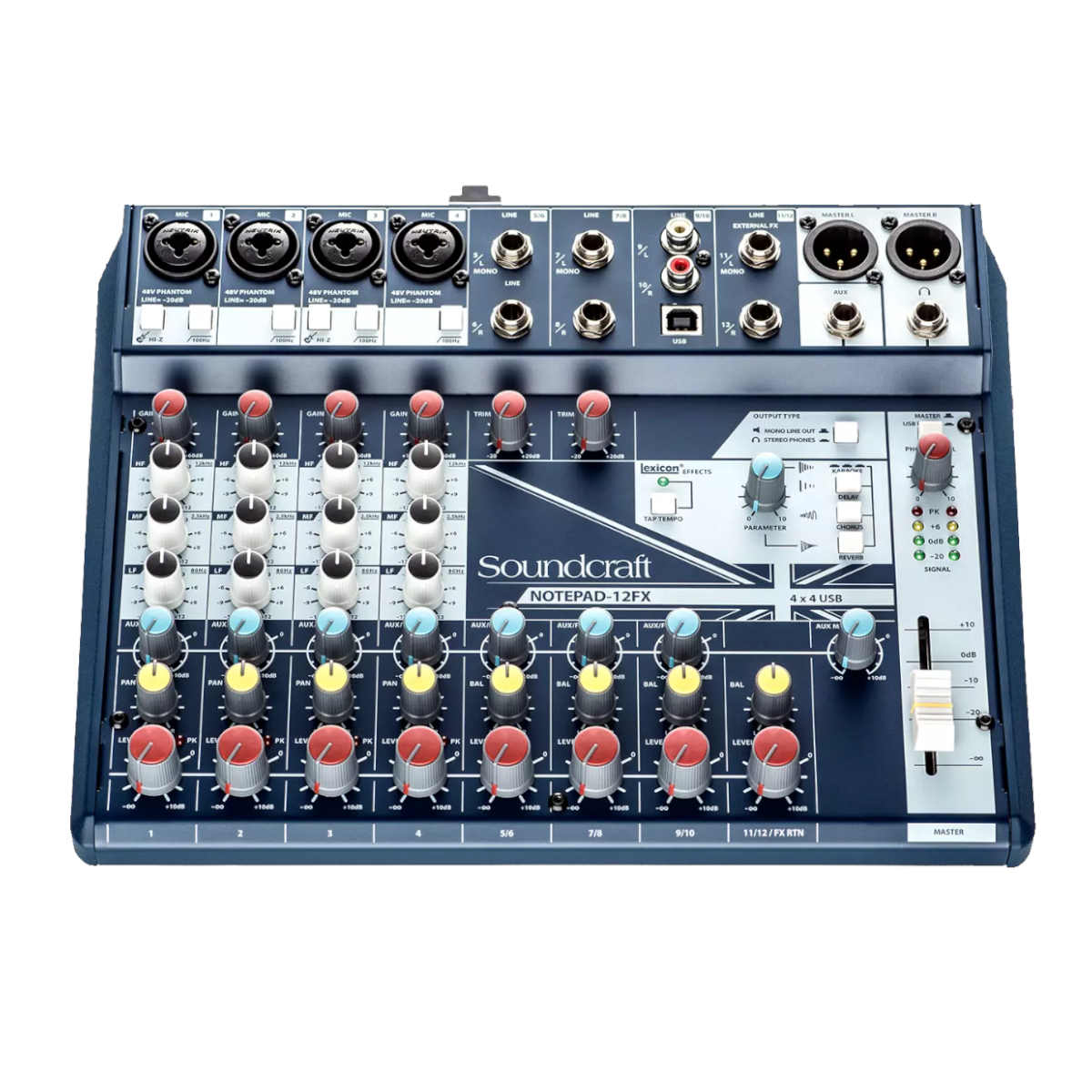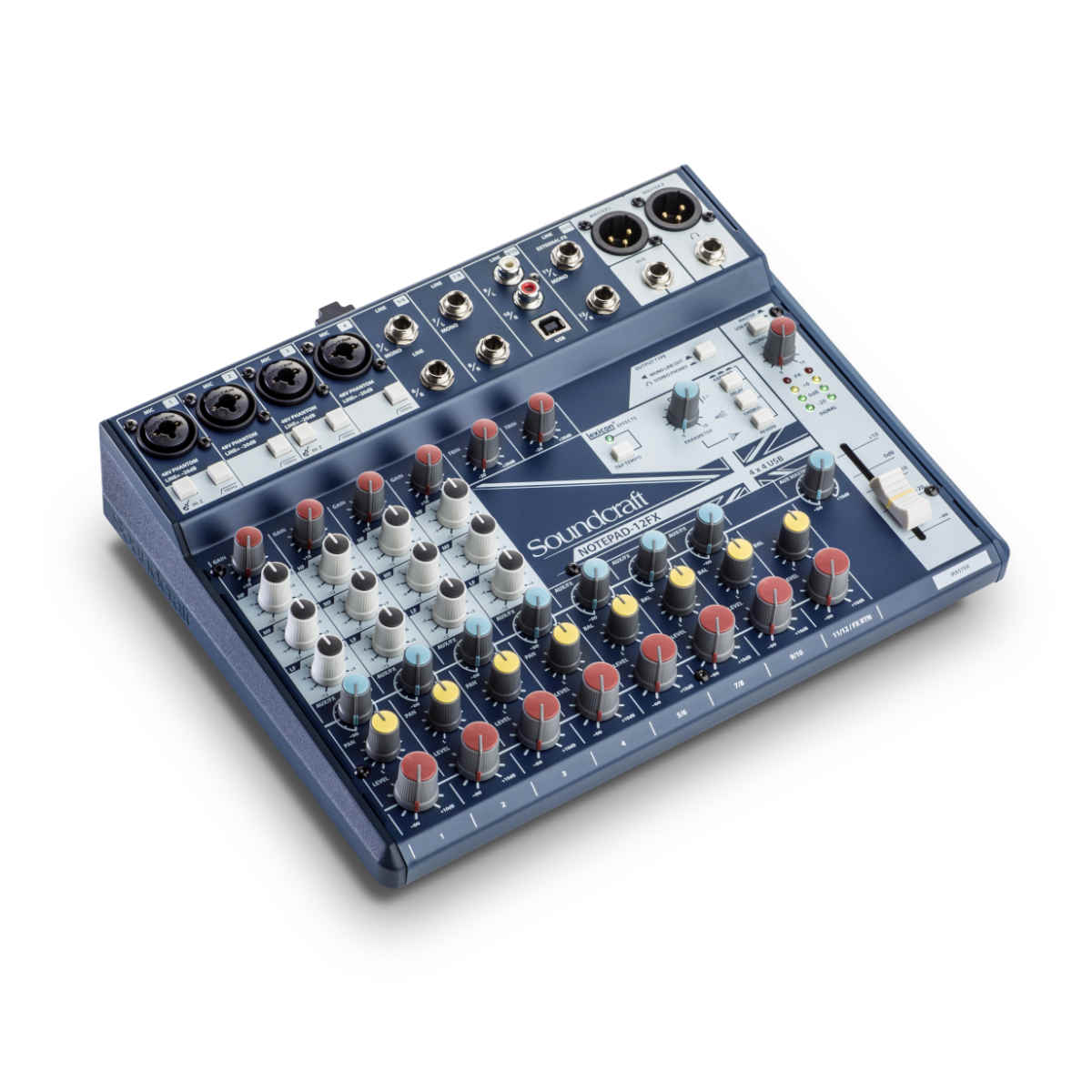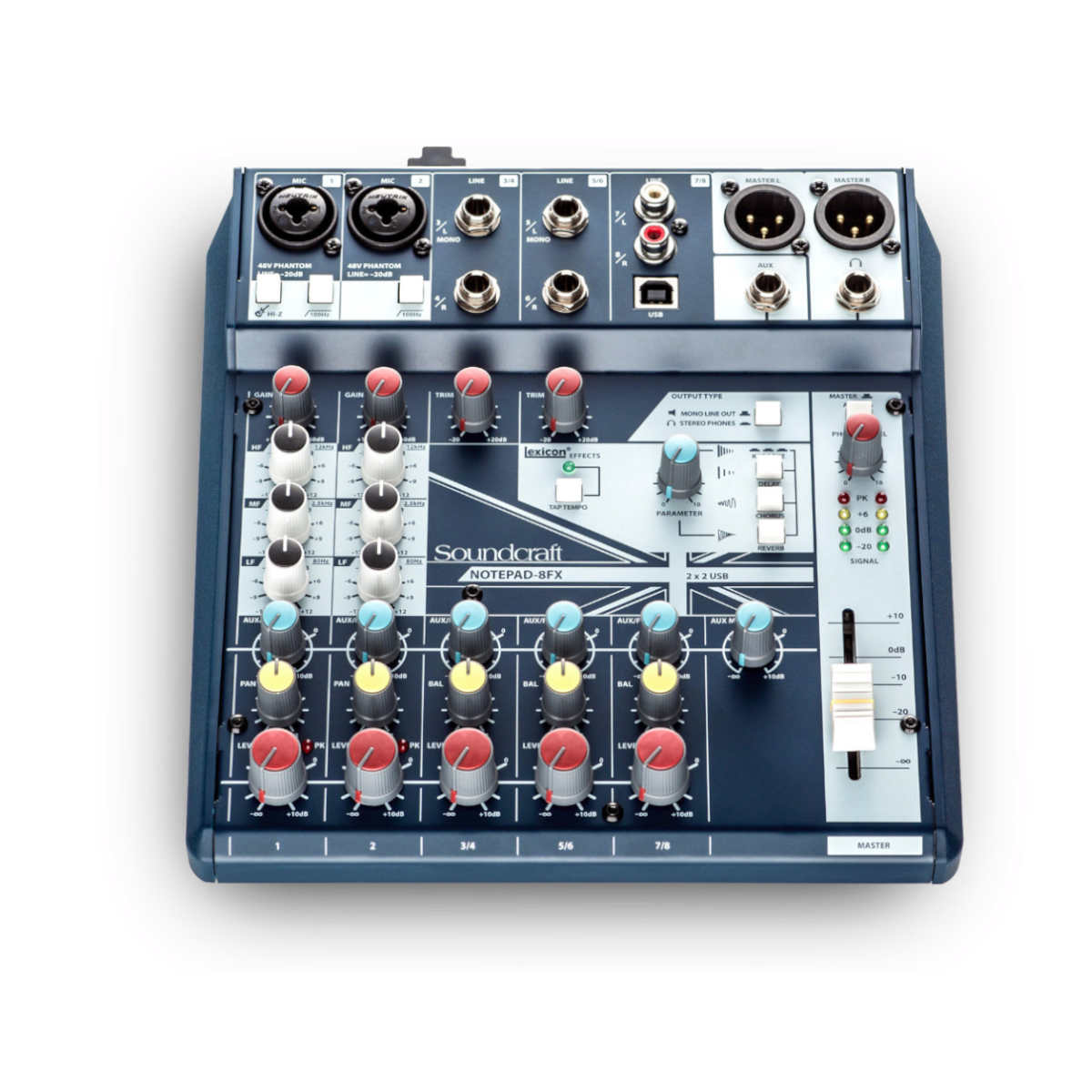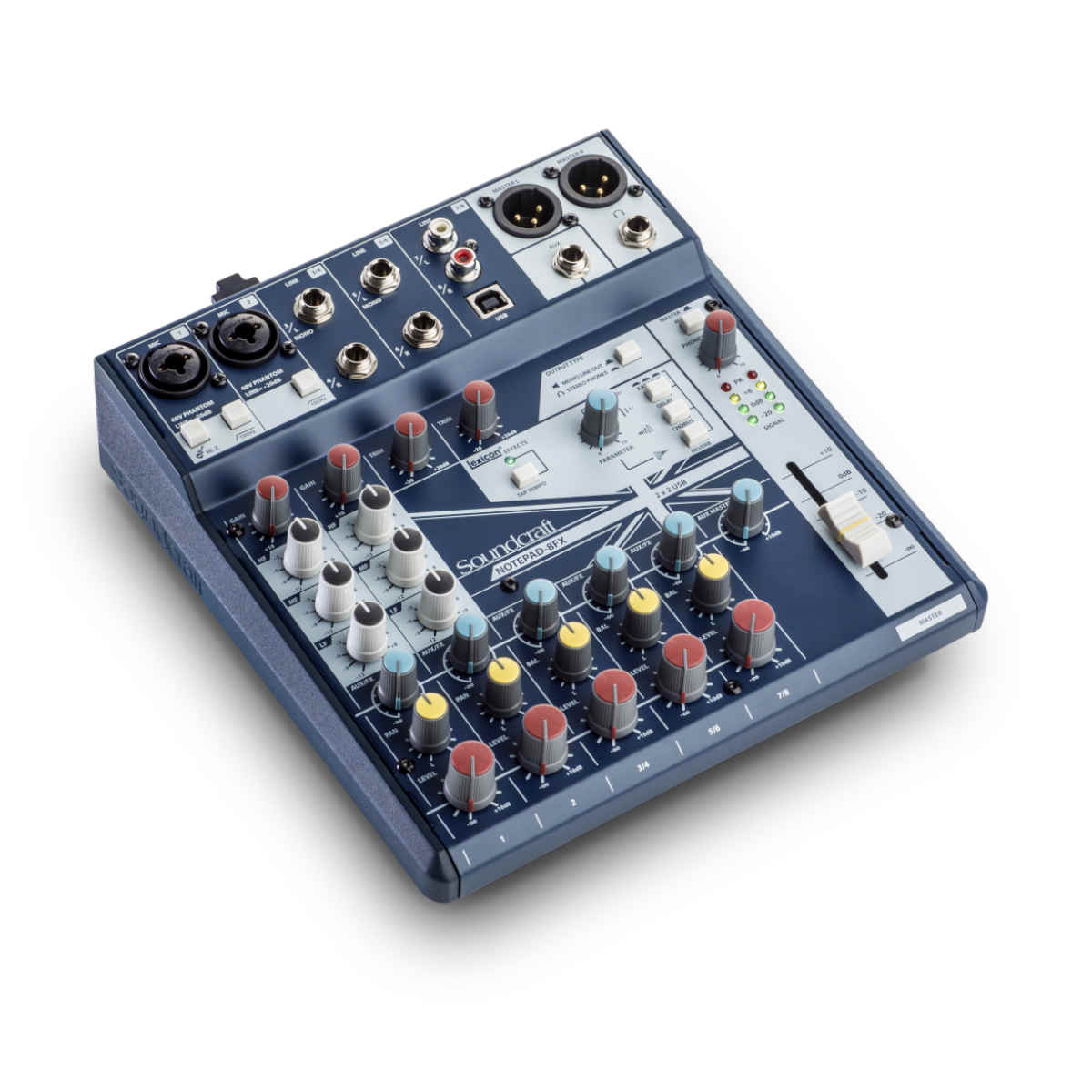-
Soundcraft Notepad-12FX Small-format Analog Mixing Console with USB I/O and Lexicon Effects

 Vendor:Soundcraft
Vendor:SoundcraftSoundcraft Notepad-12FX Small-format Analog Mixing Console with USB I/O and Lexicon Effects
- Regular price
- ₹ 18,000.00
- Sale price
- ₹ 18,000.00
- Regular price
-
₹ 18,000.00
-
Soundcraft Notepad-8FX Small-format Analog Mixing Console with USB I/O and Lexicon Effects

 Vendor:Soundcraft
Vendor:SoundcraftSoundcraft Notepad-8FX Small-format Analog Mixing Console with USB I/O and Lexicon Effects
- Regular price
- ₹ 13,648.00
- Sale price
- ₹ 13,648.00
- Regular price
-
₹ 13,648.00
Sound Mixers for the Perfect Audio Blend
A sound mixer or mixing console, is an electronic device used in sound recording, reproduction, and sound reinforcement systems to combine audio signals from various input sources. Signals from electric or electronic instruments, microphones, and recorded sounds are all examples of console inputs. Both analogue and digital signals can be controlled using mixers.
Recording studios, PA systems, sound reinforcement systems, nightclubs, broadcasting, and post-production all use mixing consoles. From providing phantom power to mics, and pan control, to filtering and EQ, along with dynamic range compression and lots more, sound mixers are typically at the core of high-value audio production for a broad range of use cases.
Types of Audio Mixers – Finding the Ideal Console
Sound mixers are broadly classified into 3 main categories:
Analog Mixers
Analog mixers are excellent for live sound and are frequently used for recording. They require either powered speakers or an amplifier with non-powered PA speakers for live sound, as well as the necessary cables to connect various sources to the mixer.
Each control on an analogue mixer serves a single purpose allowing you to see all the settings at a glance and make quick changes. They typically cost less than digital mixers but lack the automation and programmability required for sophisticated events and recordings.
Analog mixers are great for home setups where you need to stage instruments for practice. However, they have fewer onboard audio effects compared to digital mixers requiring additional outboard signal processors to achieve the same flexibility.
Powered Analog Mixers
These are nothing but analogue mixers with built-in amplification. Powered mixers are small, portable, and simple to use and offer compatibility with non-powered PA speakers. They're ideal for band practice in smaller rooms.
The majority of powered mixers feature two amp channels and have the capacity to power two main speakers or one main speaker and one monitor. Line-level outputs are common on powered PA mixers, allowing you to expand a system by adding powered speakers and monitors.
You don't need to transport separate amps when using a powered mixer. However, the compact, all-in-one design is only ideal for small-to-medium-sized spaces and can be a bit limiting for larger spaces that may require something more powerful.
Digital Mixers
Digital mixers provide a wide range of control options. You can save and recall configurations, which saves a lot of time for bands who perform in the same venues regularly. They are also useful for making quick scene changes in a theatrical setup.
Many recordings had to be mixed by hand in the pre-digital era. Several types of mixing actions such as volume fade, panning, applying effects to brief passages, and other mixing methods that have to be done on the fly, can be pre-programmed in digital mixers.
A digital mixer allows you to apply more than one audio effect to each channel without needing to purchase outboard effects equipment. However, digital mixers may prove cumbersome when quick changes are needed during a live performance owing to cumbersome touchscreen navigation.
For more information on the best sound mixer for a specific application, our team of experts can advise you on the most appropriate course of action. Now let’s take a look at some of the characteristics of good sound mixers.
Important Sound Mixer Features – Hallmarks of a Good Console
What makes a good mixer ultimately depends on what it is being used for. However, there are some standard features that are found in most quality sound mixers. We highlight a few of them here:
Mic preamps – These allow you to boost the signal coming from a mic to the correct level. Each mic input on a mixer has a preamp in it.
Phantom power – A switchable 48V supply of phantom power found on most mixers elevates the signal of a condenser mic to strong enough levels for recording.
Analog outputs – Most mixers have balanced/unbalanced outputs to get an output signal for live sound or analogue recording. Balanced XLR or 1/4" TRS outputs provide a noise-free recording.
Digital outputs – You want the mixer to have at least two channels of digital output if you want to record digitally. This allows you to record a stereo mix with your computer using USB, Firewire, etc.
EQ – There is usually some frequency equalization control for each channel on a mixer. Good EQing eliminates feedback, gives more body to instruments, and helps vocals cut through the mix. Low-cut or high-pass filters can eliminate low-frequency rumble picked up by vocal mics and prevent feedback.
Insertion (I/O) jack – Effects like reverb, EQ, or compression can be added through a pair of insertion jacks using outboard signal processors. I/O connections can be unbalanced or balanced, with higher-end models usually featuring balanced XLR.
Buses and Assignment Buttons – The input signals hop aboard and travel to their intended destination, like commuters on a bus. The output channels of a mixer are therefore called buses. It's useful to have at least as many aux/monitor outputs as the number of monitor mixes you want. Assignment buttons direct their signal to the desired output bus on each channel.
Panning – The pan control on a stereo channel adjusts the L/R balance and can also be assigned to control a mono signal onto two output buses at different relative levels.
Pad – When an electronic instrument's output is too strong for the mixer's preamp to handle, the pad lowers the incoming signal to a controllable level.
Mute buttons – The ability to mute channels and outputs when not in use is indispensable when mixing to avoid sudden peaks in amplitude. .
PFL/solo button – Also called Pre-Fader Listen, this button sends that signal to the mixer's headphone jack and output meter, letting you hear just the soloed channel, so you can check its sound quality and levels without distraction.
Subgroups – These are preliminary outputs that are used to link parts of the music together and allow per-fader volume control of multi-mic’ed parts like drum kits or backup singers.
Digital effects – Most digital and analogue mixers have digital effects like delay, chorusing, flanging and reverb that let you add an extra dimension to your music.
Compressors – Some analogue mixers feature onboard dynamic compressors that keep the signal from getting too strong or sounding too weak.
Headphone and control room outputs – When the mixer operator wants to hear the mix without room noise, these outputs can be used as they carry the same signal as the main outputs.
Digital inputs – Look for mixers that feature a USB port that can enable playing digital music for backing tracks or break music between consecutive sets.
Scribble strip – Look for digital mixers that have a virtual scribble strip, allowing you to avoid the clutter of tape and markers so you can neatly type in, save, and recall the name of each channel in every setup.
Thinking of building a home studio or pro audio workstation? Here are some other components you may want to consider.
- Studio Headphones
- Studio Monitors
- Microphones
- Midi Keyboards
- Pro Audio Speakers
- Audio Interfaces
Shop for High-quality Music Mixers Online on Ooberpad
Ooberpad is one of the leading marketplaces offering high-quality sound mixers for home and professional use across a wide range of applications. This allows you to build a capable audio system or home theatre system offering pristine audio reproduction.
Our collection of sound mixers online in India consists of leading global brands such as Soundcraft, Denon, Allen & Heath, Behringer and many more.
Buy sound mixers in India at the best price online with enticing discounts, free shipping, and 0% financing only on Ooberpad.
We offer authentic products and a team dedicated to answering any product clarification or after-sales queries to ensure 100% customer satisfaction.
Frequently Asked Questions (FAQs)
Q. What kind of mixer do I need?
A. Analog mixers are still great for live performances whereas digital mixers offer a lot more flexibility and customizability, generally allowing the user to use more than one effect per channel.
Q. How many channels do I need on my mixer?
A. This entirely depends on the input sources you have. For a small live band looking to build a recording studio, you may need anywhere from 8-12 channels.






